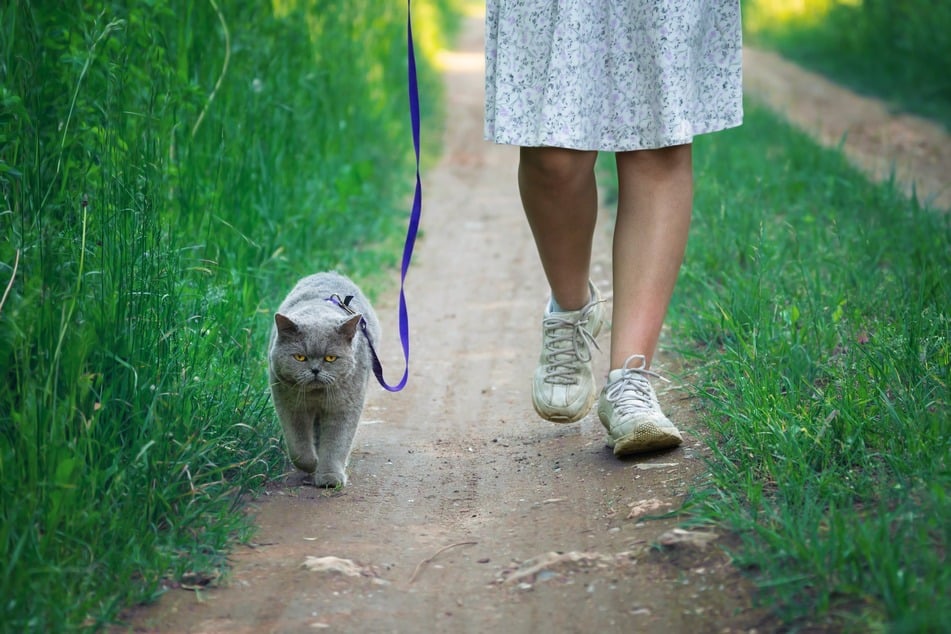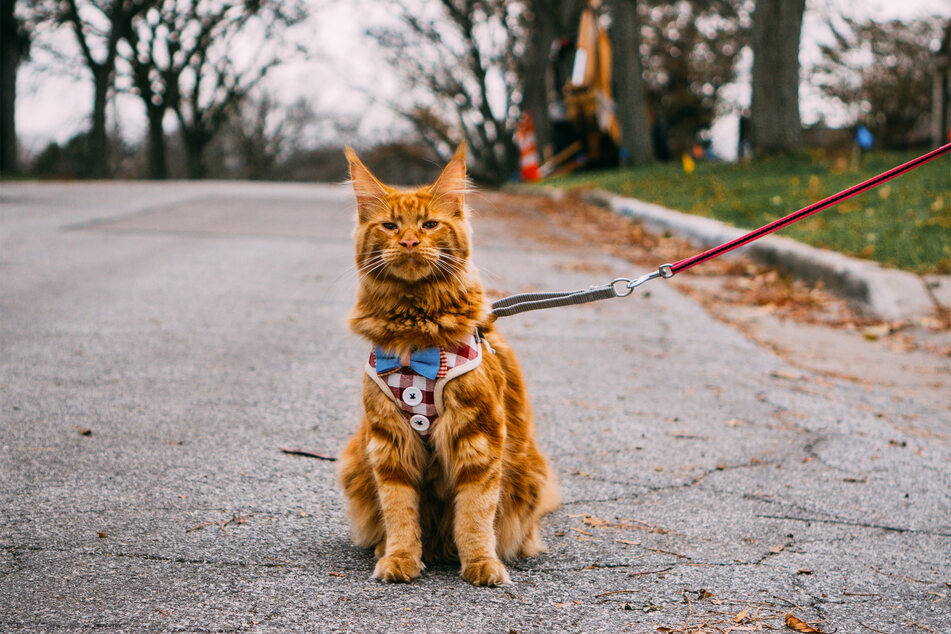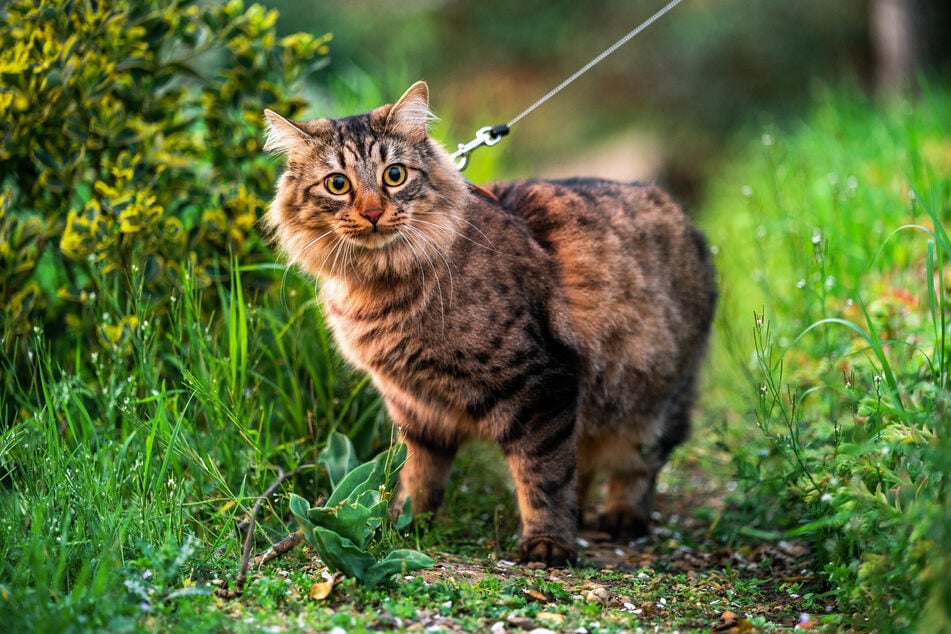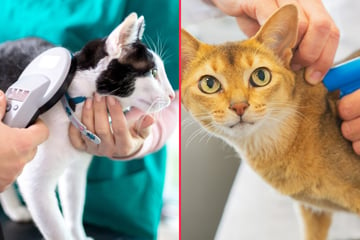Cat walking: How to leash train and walk a cat
If you live in a small apartment, it wouldn't be unusual for you to worry about your beloved kitty. After all, it doesn't have much space to explore. But can you walk your cat? And how does it work?

Walks are usually reserved for dogs, but what about our feline friends?
After all, cats are not known to be particularly obedient creatures, and they certainly won't like being tethered up.
But that's not necessarily a problem.
It depends on your personal situation, housing arrangements, and your cat's personality. For some, going for a walk could turn into a cherished activity.
TAG24's cat guide takes a look at cat walking. Can you walk a cat, and should you? Here's how to leash train your cat, and which harnesses and leashes to look out for when getting ready for your journey.
Can you walk a cat?
Yes, you can take your cat on a walk as long as it has been properly leash trained and is used to being outside in public spaces. It's not the easiest thing to achieve, though, and will require a lot of work before you can get out there and have a jolly old time. Luckily for you, we're here with some useful advice.
Here are a few things to consider doing before taking your cat on a walk
Get your cat leash trained: This is probably the most important part of the cat-walking prep process. We will detail it in the following section.
Get your cat harness trained: Before you can attach a leash to a cat, it needs to be harness trained (otherwise you have no way of attaching it). We have a guide on cat harness training that's perfect for you.
Explore your immediate surroundings first: Make sure to start off slow, allowing your cat to go a short distance around the front door, maybe half a block up the road but no further. After it is leash trained, take it short distances and gradually increase it to a full walk over time.
Keep your cat indoors after a move: If you've already got used to walking your cat but move houses and neighborhoods, it's still best to take it easy at first. Make sure that your cat stays inside and starts to think of the new house or apartment as its home. This way it will return there if it gets away.
There is a very big difference between your cat free-roaming by itself and being leash walked by you. Cats will naturally keep to the shadows and avoid things that might be dangerous or scary to them, an option that is removed if they're practically tethered to you. This cat anxiety this could cause means that while walking your cat is possible, it might not always be the best idea.
Ultimately, your cat should feel comfortable, happy, and safe before you take it outside on a leash. Make sure that it has been properly trained as needed, knows its home instinctively, and is well acquainted with the local environment.
How to leash train a cat
Leash training your cat can be a long and arduous process that'll induce many scratches and hisses. Cats don't naturally like being put in any form of clothing, much less dragged around on a rope like a dog! Still, if you live in a small space and this is the only way your kitty will ever get fresh air? It's not a bad idea to get it properly leash trained.
Here's how to leash train your cat
Step 1: Check that there's no professional trainer! It's hard to train your cat to walk on a leash – it'll be easier if you have the ability to hire a proper trainer who'll sort it all out for you.
Step 2: Make sure that your cat has been fully and properly harness trained before you begin leash training.
Step 3: Attach the leash and walk around with your cat on a regular basis, without any tension and without exerting control.
Step 4: Start exerting a little bit of control by stopping your kitty from doing certain things and going to certain places, making it sit and wait in the meantime.
Step 5: Continue to walk your cat around in the house, taking care to slowly start getting it to walk with you rather than you with it. Do all of this gently, by lightly tugging it along the way you want to go.
Step 6: Once it is all set and ready, it's time to go outside. Start slowly, only walking around a few meters or simply going into the hallways if you're in an apartment complex.
Step 7: Gradually increase your distances and start creating routines. Always walk the same way so that your cat knows where it is at all times.
Step 8: Over time your cat will become more confidant and relaxed, and may even start to enjoy the experience. Keep walking your cat, getting it exercise, snack, and treats along the way as well!
Using these simple steps you'll be walking your beloved feline friend in no time at all! Leash training might seem complicated and scary, but it's really not, and it's worth every penny!

Making sure the cat harness and leash is escape proof
The most important thing to do when choosing the harness and leash is to make sure that they are both comfortable for the cat and nigh-impossible to escape from. If you go for a long walk, a good distance from home, and your cat escapes, you're going to be in a world of trouble – so this is really important.
Here's how to make sure that your harness is escape proof:
- Is it good quality? Is the harness you have chosen of a high quality and designed well for your cat's size, shape, and weight? Don't go for cheap options.
- Is it positioned correctly? You need to make sure that the leash isn't too tight and has a bit of slack in it, to stop the cat from being able to back out of the harness. On top of that, the angle of the leash should be kept relatively high.
- Have you trained your cat? Proper leash and harness training is critical as it will make your cat less likely to try and escape, and will make you better at handling your cat when it tries to do so as well.
Ultimately, it all comes down to the quality of your walking setup and the training that both you and your kitty have gone through. Without these two things, your cat will escape easily and walking will be extremely risky.
Best cat harness and leash

The best recommendation here is talking to your vet and getting some tips on the right leash for you and your cat. Alternatively, staff at pet stores are often trained in this stuff as well.
Here are some factors you should, however, focus on when choosing yourself the best harness and leash:
- Is it comfortable?
- Does it fit properly?
- Is it easy for your cat to escape from?
- Does it cause any pain?
- How is the strap rotation, to allow your leash plenty of different angles?
- How easy is it to put on?
- Could it cause strangulation?
- What material is it made out of? Is your cat allergic?
- How sturdy is it, could it break?
- Is it lightweight?
- How do you wash it?
It's important to make informed decisions when it comes to these kinds of products. Check with people in the know-how, take some time, and choose the safest option not the cheapest or most expensive.
Taking your cat for a walk can be a good idea in cities
If you live in a small, cramped apartment in the middle of the city, life can be very hard for your kitty. While you can get inside cats, they still need plenty of space and equipment to climb around on and explore. Cats need exercise just like humans, and they need plenty of activities to fill their time with and keep them away from the dangers of boredom.
Getting your cat harness and leash trained can be a great solution. That way you'll always have the option to go for a walk, give your kitty a lot of exercise, and allow it to scratch that curiosity itch safely.
Cover photo: 123RF/dzurag



